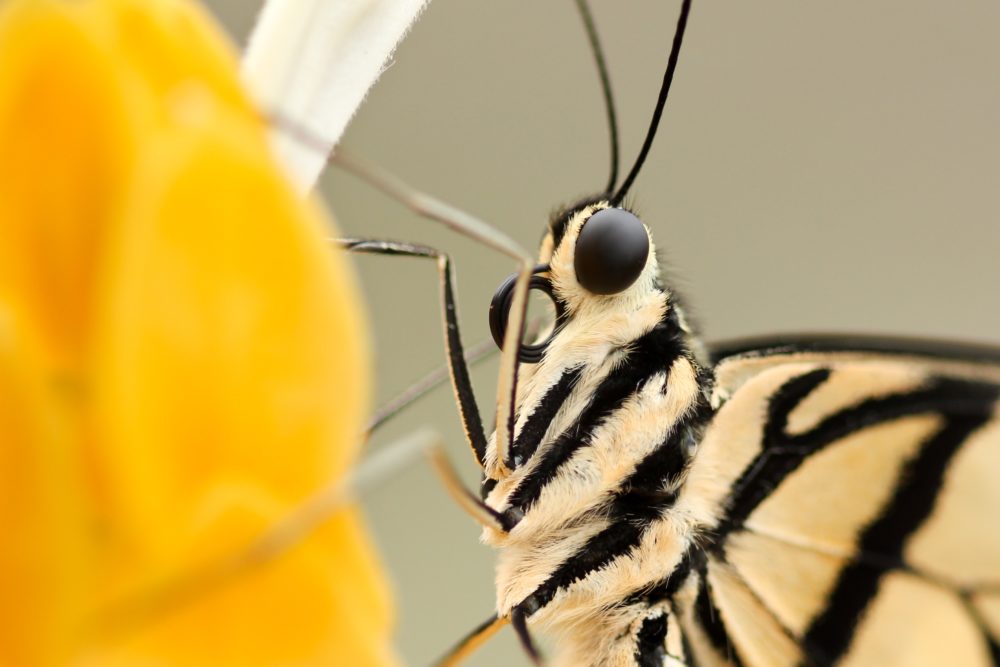For several years, I have been captivated by a porpoise. The cetacean in question is the vaquita, a Mexican marine mammal that is shy, adorable, and totally screwed. The reasons for its imminent demise are too complex to explicate here — read the story, people! — but suffice to say that it’s doomed by the unholy alliance of our insatiable appetite and our global economy. Although the vaquita is no longer as obscure as it once was, it’s still damned difficult to make people care about such a cryptic creature. Writing about the vaquita’s struggles in 2016 — and 2017, and 2018 — felt like tossing pebbles against a locked window, the blinds drawn and shutters closed.
Where once there were bugs
Storyboard has partnered with The Open Notebook for a deep dive on "The Insect Apocalypse is Here." In our piece, environmental journalist Ben Goldfarb analyzes how Brooke Jarvis cuts through the noise of environmental gloom to gain readers' attention. To eavesdrop on a conversation between Goldfarb and Jarvis about how Jarvis found, reported and wrote this story, see Brooke Jarvis Uncovers an Insect Armageddon. ![]()
Trying to inspire passion about extinction — and climate change, and drought, and deforestation, and sea turtles with straws sticking out of their snouts — is part and parcel of environmental journalism. It’s a beat that manages to be both unremittingly depressing and grindingly unsexy. Save the occasional oil spill or wildfire, few environmental stories bleed/lead. Our planet’s ailments are more like heart disease than gunshot wounds, no less fatal for being chronic. How do you craft captivating narratives about distant and insidious crises? How do you sound the alarm without so distressing readers that they bail after the nut graf?
One of the journalists who most nimbly walks that tightrope is Brooke Jarvis, a contributing writer at the New York Times Magazine and California Sunday Magazine. In recent years, Jarvis has covered plastic-eating albatrosses for Pacific Standard; profiled the Australians who can’t accept the extinction of the Tasmanian Tiger for the New Yorker; and eulogized a baby orca, a New York times obit that, I have learned from hard experience, you should not read in a coffee shop unless you’re okay with tearing up in public.

“It’s been hard to decide what to work on next, because it never feels like time for your fun, whimsical stories,” Jarvis told me with a sigh when we met at her home in Seattle. (You can read the entire conversation over at The Open Notebook.) “It’s fucking depressing out there!”
Exhibit A: Jarvis’s magnum opus, "The Insect Apocalypse is Here." The story, which ran on the New York Times Magazine’s cover the week of November 27, 2018, chronicled the largely unnoticed collapse of bees, beetles, butterflies, and other six-legged critters, a phenomenon equal parts mysterious and horrifying. The story was that rarest of species, a tale of environmental catastrophe that broke through. “Insect Apocalypse” has been viewed more than a million times online, and shot to the top of the Times’ most-shared list. Yes, you read that right: In the eye of last year’s Category-5 news hurricane, one of the Grey Lady’s most popular stories was about bugs. Bugs!
So how’d she do it? I want to call attention to three things that made this story so resonant:
1) Environmentalists, other environmentalists are fond of complaining, gravitate toward problems and symbols that are distant to lived American experience — the elephant murdered for his tusks, the polar bear on the shrinking ice floe. Personally, I don’t object to that: Our empathy for non-human animals is one of the few traits that redeems our slovenly species. Still, grounding ecological issues in relatable human struggles often produces powerful reportage. A prime example is “Finding Middle Ground,” Meera Subramanian’s intimate series for Inside Climate News that examines how climate change deniers conceptualize their ruined peach orchards and mushy dogsled races.
Jarvis, too, deliberately led her story not with a scientist, but with a civilian: Sune Boye Riis, a Danish teacher whose connection to insects is simply that he’s freaked out by their absence. “I wanted people to be able to identify with his experience,” she told me. “It’s so personal and creepy and startling, and I think that’s a big part of why people have been interested in this story.” Very few of us have PhDs in entomology, but we can all relate to the hunch that the natural world is deteriorating. When Jarvis was 12, her family drove an RV to Disneyworld and had to stop every hundred miles to squeegee bugs off the windshield. Now that cloud of life has vanished, perhaps forever. “A lot of people have similar memories,” Jarvis told me. “‘It used to be like this, and now it’s not.’”
The response to “Insect Apocalypse” suggests how deeply its audience connected. No trolls lurking in this comment section; instead, it’s a bittersweet, clover-scented stroll through the pastures of nostalgia. Here’s one reader's online response:
When I was a child in upstate New York, I would mow our hayfield and it would stir up hundreds of insects per foot. Bluebirds and swallows followed my tractor. Today, that same field has no insects at all.
And a comment that should be accompanied by lugubrious violins:
My grandchildren have never seen a grasshopper.
2) Ecological narratives are often, at bottom, mysteries. What’s the source of Florida’s algae blooms? How did lead infiltrate Flint’s water? Why are starfish melting? Hell, even the book that launched the modern green movement was a whodunit: How’d spring get so silent, anyway?
From the get-go, Jarvis recognized that her narrative would have to be suspenseful. “Insect Apocalypse” less resembles a tidy Agatha Christie caper than the opening scenes of, say, “Jaws” — you know there’s something huge and terrifying down there, even if you haven’t seen the monster. “I always thought of this story as the beginning of a horror movie, where there’s just something that’s a little bit off, and you don’t know whether to take it seriously, but you notice it and it’s weird and foreboding,” Jarvis told me.
Steven Spielberg isn’t subtle in his evocations of eeriness, and neither is Jarvis. In the story’s very first paragraph, we hear that “something… was amiss. Specifically, something was missing.” Scientists, we learn, feel a “loose suspicion of wrongness.” Riis’s “nostalgia gave way to worry;” he frets about missing bugs like Richard Dreyfuss obsesses over Devil’s Tower in “Close Encounters of the Third Kind.” The very fact that insects are understudied — potentially a hole in the claim that they’re declining — becomes, in a brilliant shift, an opportunity to advance the mood. From her story:
Because insects are legion, inconspicuous and hard to meaningfully track, the fear that there might be far fewer than before was more felt than documented. People noticed it by canals or in backyards or under streetlights at night — familiar places that had become unfamiliarly empty.
Jarvis admits that her first draft overdid the ominousness: “I remember looking for synonyms for foreboding,” she told me. In the final version, the creepy vibes are pitch-perfect.
3) A more prosaic version of this story — the version I might have written — would have foregrounded the ecological problems associated with insects’ collapse. You’ve got to make people care about creepy-crawlies, right? So: What happens when we no longer have bees to pollinate our crops, dung beetles to roll up our waste, moths to dispose of the ratty old sweaters in our closets? It’s the bugs, stupid!
But here’s the great secret of “Insect Apocalypse”: it’s only ostensibly about insects. Every feature Jarvis writes, she told me, is really two stories. There is, first, the plot story — in this case, the disappearance of bugs — which is welded in turn to an idea story, a philosophical grand narrative. Her Tasmanian tiger story is about how hope, no matter how unrealistic, can guard against despair; her albatross story is about which messages spur us into action. (Jarvis said she keeps a list of prospective grand narratives in need of plots, though she was understandably reluctant to share examples.)
In “Insect Apocalypse,” the grand narrative revolves around the frailty of long-term memory, and how readily we accept our degraded present as normal — a phenomenon scientists call “shifting baselines syndrome.” The concept of shifting baselines has been explored before, but rarely as lucidly as Jarvis states it in her story:
The world never feels fallen, because we grow accustomed to the fall.
More than cockroaches and crickets, “Insect Apocalypse” is about why we don’t notice the world changing beneath our feet — a question that crosses disciplines, leaping from ecology to psychology.
In fact, that’s the wonderful thing about covering conservation: Often, stories whose scopes seem narrow — the vanishment of bats, the melting of ice — turn out to contain themes that are biblical in their vastness. Environmental stories are about our all-consuming hungers, our overweening need to dominate nature, our lamentable inability to contemplate time-scales longer than a human life. Masterful writers like Emma Marris and J.B. McKinnon have shown that even non-human characters can evoke powerful human emotions — and demonstrate the limits of our own species’ compassion.
Swimming in such deep waters, of course, can wear you out. As Marris, herself no stranger to weighty material, put it on Twitter last year, “I hope @brookejarvis has a good therapist, because she has been writing about some seriously heavy shit lately.”
When, on January 31, 2019, Jarvis’s latest feature dropped in California Sunday, I clicked eagerly, wondering if she’d finally found time for whimsy — an interview with a boutique rabbit breeder, perhaps, or a dispatch from a spicy pepper-eating contest. Instead, she’d profiled American-born children who’d returned to Mexico with their deported parents.



